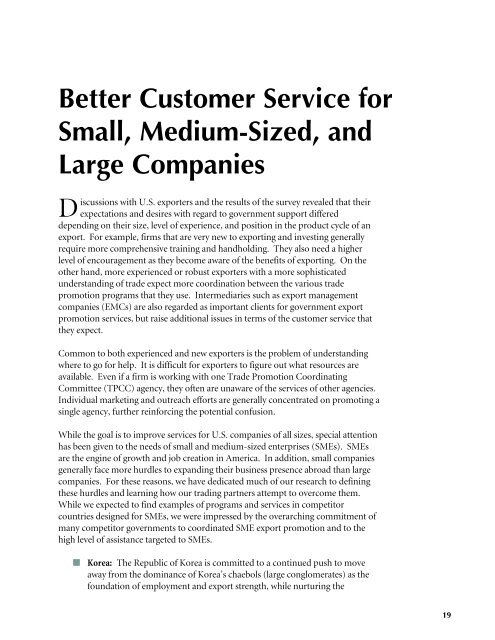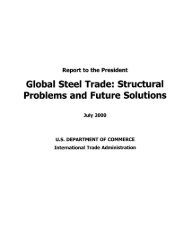National Export Strategy 2002 - International Trade Administration ...
National Export Strategy 2002 - International Trade Administration ...
National Export Strategy 2002 - International Trade Administration ...
You also want an ePaper? Increase the reach of your titles
YUMPU automatically turns print PDFs into web optimized ePapers that Google loves.
Better Customer Service for<br />
Small, Medium-Sized, and<br />
Large Companies<br />
Discussions with U.S. exporters and the results of the survey revealed that their<br />
expectations and desires with regard to government support differed<br />
depending on their size, level of experience, and position in the product cycle of an<br />
export. For example, firms that are very new to exporting and investing generally<br />
require more comprehensive training and handholding. They also need a higher<br />
level of encouragement as they become aware of the benefits of exporting. On the<br />
other hand, more experienced or robust exporters with a more sophisticated<br />
understanding of trade expect more coordination between the various trade<br />
promotion programs that they use. Intermediaries such as export management<br />
companies (EMCs) are also regarded as important clients for government export<br />
promotion services, but raise additional issues in terms of the customer service that<br />
they expect.<br />
Common to both experienced and new exporters is the problem of understanding<br />
where to go for help. It is difficult for exporters to figure out what resources are<br />
available. Even if a firm is working with one <strong>Trade</strong> Promotion Coordinating<br />
Committee (TPCC) agency, they often are unaware of the services of other agencies.<br />
Individual marketing and outreach efforts are generally concentrated on promoting a<br />
single agency, further reinforcing the potential confusion.<br />
While the goal is to improve services for U.S. companies of all sizes, special attention<br />
has been given to the needs of small and medium-sized enterprises (SMEs). SMEs<br />
are the engine of growth and job creation in America. In addition, small companies<br />
generally face more hurdles to expanding their business presence abroad than large<br />
companies. For these reasons, we have dedicated much of our research to defining<br />
these hurdles and learning how our trading partners attempt to overcome them.<br />
While we expected to find examples of programs and services in competitor<br />
countries designed for SMEs, we were impressed by the overarching commitment of<br />
many competitor governments to coordinated SME export promotion and to the<br />
high level of assistance targeted to SMEs.<br />
■ Korea: The Republic of Korea is committed to a continued push to move<br />
away from the dominance of Korea’s chaebols (large conglomerates) as the<br />
foundation of employment and export strength, while nurturing the<br />
19
















